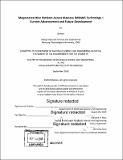Magnetoresistive Random Access Memory (MRAM) technology : current advancement and future development
Author(s)
Lnu, Shimon.
Download1126335286-MIT.pdf (15.26Mb)
Other Contributors
Massachusetts Institute of Technology. Department of Materials Science and Engineering.
Advisor
Caroline A. Ross.
Terms of use
Metadata
Show full item recordAbstract
Ability to store data is one of the key utilities in modern computer. The memory industry grows as demand for denser, smaller, cheaper and faster memory device increases. The term memory has been used widely in computing jargon to refer to random access memory (RAM). RAMs are built with steady improvement over the years owing to semiconductor integrated circuit (IC) technology. However, RAMs are still struggling to achieve all aspect of the paramount design intended for memory device: non-volatile (including radiation hardness and materials stability), dense, fast, low power consumption, low cost, IC technology compatible and read/write (R/W) endurance. Magnetoresistive RAM (MRAM) offers such possibility. MRAM has just entered in 2002 with 128kbit product, but it has improved to reach 16 Mbit density in the year 2009, that makes a 128 density multiplication in 7 years. The prototyping has gone through an even higher density at 64 Mbit in 2010, along with optimistic view of reaching Gbit density in the near future by the introduction of spin-torque-transfer MRAM. A close look at the presented MRAM cost model, the cost of 64 and 128Mbit module can go as low as 4.4-4.9 cents/Mbit and 2.8-3.0 cents/Mbit respectively. Comparing to similar density (64 or 128 Mbit) DRAM product - around 1993-1996, DRAM pricing is revolving around $1/Mbit, which makes MRAM a cost competitive product with respect to DRAM or other memories. Evidently, MRAM cost looks promising to compete with superior memory products such as DRAM and Flash, while on its way, it will replace the first few market penetration areas such as embedded memory and SOC circuit for mobile/automotive application.
Description
Thesis: M. Eng., Massachusetts Institute of Technology, Department of Materials Science and Engineering, 2010 Cataloged from PDF version of thesis. Includes bibliographical references (pages 80-85).
Date issued
2010Department
Massachusetts Institute of Technology. Department of Materials Science and EngineeringPublisher
Massachusetts Institute of Technology
Keywords
Materials Science and Engineering.